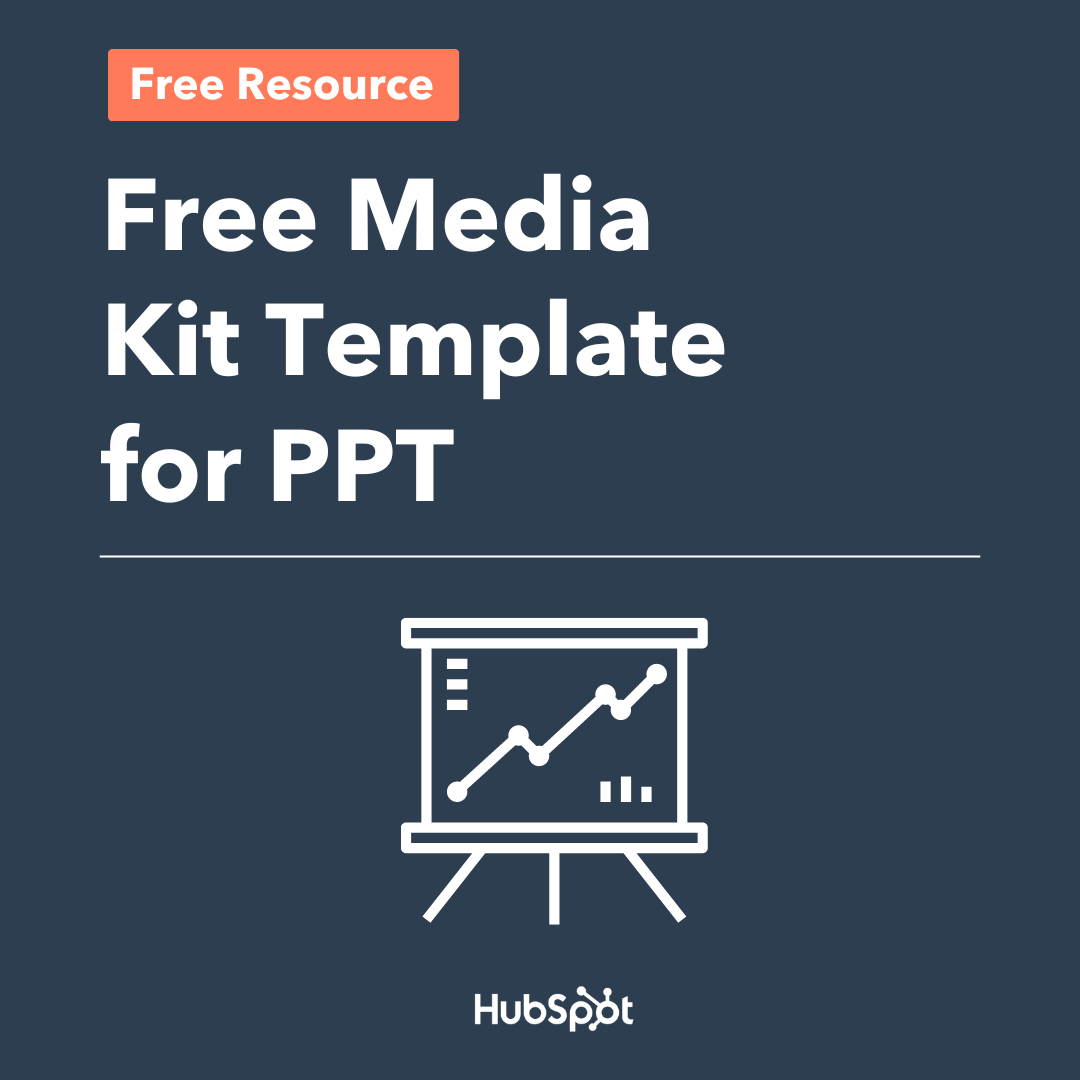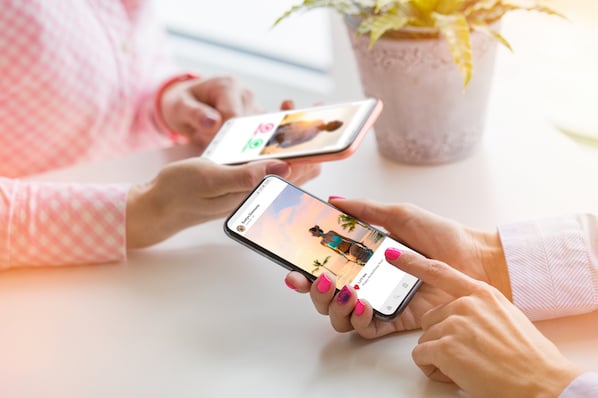A well-known adage says there’s no such thing as bad press — but let’s be real: that’s a big ol’ lie.

Whether you’re a new or tenured brand, media coverage can have a massive impact on how you are perceived by your target audience.
That’s where a media kit (a close cousin of the press kit) comes in. 
With a well-strategized media kit, you help guide media/press conversation and position your product and business the way you want. And hey, you also make promoting and praising your brand easier.
As a branding and planning nerd, I've always been interested in media kits. So, let’s unpack how to make a great one.

Free Media Kit Template
Simplify your media outreach and get noticed faster by using our free media kit.
- Save time & money
- Have a professional look
- Get inspiration and ideas
- And more!
Table of Contents
- What is a media kit?
- Media Kit vs Press Kit
- What to Include in a Media Kit
- How to Make a Media Kit
- Media Kit Design
- Media Kit Examples
What is a media kit?
A media kit is a set of promotional materials curated for those in digital media (i.e., bloggers, influencers, content creators). It is similar to a “press kit,” which is focused on enabling more traditional press and journalists to write articles, but more comprehensive. Besides press releases and images, a media kit contains additional assets and information like videos, statistics, social media profiles, awards, case studies, and branding guidelines.
Now, I’d be remiss if we didn’t clarify one thing before diving any deeper into the media kit waters: What’s the difference between a media kit and a press kit?
Media Kit vs Press Kit

I can’t lie to you — when I sat down to write this piece, I thought a media kit and press kit were the same thing.
Many people use the terms interchangeably, and it’s easy to see why. Both a media kit and a press kit serve the same purpose — enabling accurate promotion for your company. But there are some key differences.
“Press kit” is a more traditional term for materials compiled for journalists or news media to write about you. It typically includes press releases, images, background information (like a company overview), and contact details.
A “media kit” is all of that and more. It is a more modern term for promotional assets curated primarily for those in digital media — think bloggers, influencers, content creators, and affiliates.
Besides press releases and images, a media kit includes branding guidelines, social media information and statistics, videos, awards and accolades, partnerships, and maybe even case studies.
(Note: Many brands will take the term “media kit” literally, only including multimedia like images and videos. X, formerly Twitter, does this, for example.
But for the purposes of this article, we’ll focus on an all-encompassing kit, as we described above.)
Traditional journalists can undoubtedly use a media kit like their digital counterparts, but press kits lack the details digital creators need.
That said, I’d argue that a media kit is simply a modern, more relevant evolution of the press kit.
.png)
Free Press Release Template
A free guide and template to help you run your company's PR.
- Company Announcements
- Promotion Checklist
- Guide to PR Best Practices
Download Free
All fields are required.
.png)
What are media kits and press kits used for?
In a nutshell, both media and press kits are used to gather information about your product or company to share with outside parties.
They don’t get you more media coverage, but they do make creating that content easier. They also help ensure that the content produced is aligned with your brand and positioning.
For example, if a magazine writes an article about you, your media/press kit will share the background information they need to do it in the right terms and tone of voice.
Or, if someone is creating a social media video about you, they’ll know how they should use your logo or what colors are on the brand. I dabble in user-generated content creation for brands myself, so I can vouch this is a common use.
Overall, a media kit or press kit fosters convenience and consistency when working with an external partner.
What to Include in a Media Kit
So, here's some good news: most of the content and creative assets you need to create your media kit likely already exist. Let’s unpack the essentials.
1. Company Story (Mission, Values, etc.)
Start with the star of your media kit: you. This is where you introduce your name, logo, and mission. Share your origin story and overall, the “why” behind what you do.
Golf equipment company Titleist does a beautiful job summarizing its story on the “About Us” page of its Media Center.
Reminiscent of an executive summary, visitors finish the page knowing who Titleist is, how long it has been in business, and what they can expect from the brand. An “about us” like this is also commonly found in a press kit.
2. Products/Offering
This may be obvious, but include an overview of your product, service, or offering in your media kit.
Sometimes, people outside your organization don’t know how to describe what you do, your catalog, or your trademarks. Use this space to lay down the facts.
Design tool Canva does many things right with its media kit website, but I especially love how it highlights its products. The design software company employs a colorful slide deck to detail the products. But here’s the kicker: It’s designed on the platform itself. Talk about inception.
The website also offers a brief overview of the company’s product offerings on the “company information” tab making it easy to find the information when needed.

3. Founder/Management Information
Media outlets are often interested in speaking to company founders or executive team members. Use your media kit to highlight them with their names, brief bios, and headshots. This is another feature you’d find in a traditional press kit.
While GE Appliances’ media kit doesn’t include a dedicated, separate page for learning about its leaders, it does include a link to their bios.

This streamlines the company's media kit creation time but still makes it easy for visitors to find the information they need.
Pro Tip: You may also want to include short quotes from them reflecting their area of expertise or unique points of view. Even better, share your company story from their point of view.

Free Media Kit Template
Simplify your media outreach and get noticed faster by using our free media kit.
- Save time & money
- Have a professional look
- Get inspiration and ideas
- And more!
4. Brand Overview
This section of your media kit is especially important when working with content creators and influencers.
Does your brand try to align with a certain lifestyle? Do you have branded words, phrases, or even taglines? What are your values? Does your name have an unexpected pronunciation or spelling?
Including a brand overview in your media kit allows you to document these elements precisely to your liking and communicate them to potential collaborators.
These guidelines also help identify who is or is not a good match to represent your brand. In its media kit, Give Lively details its company brand, including its brand values.

Here’s what I would include in a brand overview:
- Taglines
- Branded Terms and Trademarks
- Brand Values
- Brand Voice
- Tone
- Unique Spellings
- Pronunciations
5. Visual Assets & Guidelines
Your media kit isn't a full style guide. However, it should pull in the most essential elements of your visual brand and explain how to use them.
Use your media kit to include logos and product/service images.
Do you want your product shown in particular scenarios? Include high-quality images creators, or journalists can choose from. Are there specific ways you want your logo to be displayed or used?
Provide examples of correct and incorrect uses. Apple does a great job of showing exactly how it wants its branded badges to be used and how not to use them.

This is your opportunity to clarify how you want to be portrayed and make it easy for media folks to do so.
Pro Tip: Make sure your media kit design reinforces your overall brand identity. Use the colors, fonts, and other visual hallmarks from your branding guidelines. Be the example of what you want to see from others.
6. Social Proof (Social Media Stats, Case Studies, etc.)
According to Matter Now, 69% of consumers trust influencers, friends, and family over brands themselves. So, use social proof to your advantage.
In your media kit, share third-party information that vouches for your quality or success like:
- Social Media Statistics
- Case Studies
- Testimonials
- Awards
Social Media Statistics
If your goal is partnerships and collaborations, your media kit should prioritize engagement rates and similar social media metrics alongside the bread-and-butter statistics like follower counts.
Savvy creators and media companies want to partner with brands with big reach and engagement.
For social stats, you'll need to conduct a social media audit or collect this data from the person who manages your social channels.
Pro Tip: If you are a HubSpot Social user, you can use Reports to analyze the performance of your social posts and determine how well your social media efforts are performing.
Case Studies
This section is your chance to let your work speak for itself. Let the adage "show, don't tell" guide you here, featuring the right partnerships — either via logos or short case studies.
International football influencers The F2 highlight past campaigns on their website, putting reputable brand names and logos front and center. They also note key engagement statistics for these campaigns.
Testimonials
Testimonials are another great way to show the impact and effectiveness of your brand or product in your media kit.
Keep this section succinct: just one or two strong quotes should suffice.
A few lines of text (even just a single short quote) and a single related image can get the point across and leave a lasting impression.
Awards
Share any awards or accolades your business has received from reputable associations or trade groups. These awards once again vouch for the quality and legitimacy of your work.
7. Existing Press
Do you have samples of past press you loved? How about press releases? If so, include them in your media kit here. Shoe brand Nike has an extensive collection of press releases on its press website.

If your business has been featured on a podcast or TV show, include a link to the clip or file. Mentioned in an article on a prominent publication or other media outlet? Quote it.
You can also consider simply showing the logos of the other media outlets that have covered you and linking to the asset if available.
Including existing press helps new partners see what a great finished product can look like and adds a little extra social proof of your prestige.
8. Contact Information
Consider this the call-to-action of your media kit. Include any relevant contact information that people can use to connect like:
- Press email address
- Social media handles and links
- Relevant hashtags
Cannabis company Verano makes it easy to find contact information, including social media profiles in its media kit.

Extras
Depending on your company's goals, there are many other things you can consider including in your media kit.
For example, if you are vocal about particular social causes, you may want to include information about those efforts. Highlight any charity or non-profit work. Or, maybe you’ll want to share financial data, like market share and sales numbers.
Take LVMH for example. The parent company of Fenty Beauty by Rihanna, highlights the brand’s scale by sharing how many countries it is present in and the number of foundation shades it offers.

Think about what you want your organization to be known for and let that guide what you include in your media kit.
How to Make a Media Kit
- Write your company story.
- Add founder/team information.
- List critical milestones and accomplishments.
- Gather your supporting assets.
- Compile in the format of your choice.
- Add to your website.
1. Write your company story.
Start your media kit by writing a brief overview of your business. I recommend writing the basic facts (like founding date, location, and founder names) and then elaborating on your mission, company size and growth, product and service evolution, and accolades.
While you want to keep this concise, you also want to ensure your reader gets a well-rounded image of your company. You want them to be excited to promote and learn more about you.

Free Media Kit Template
Simplify your media outreach and get noticed faster by using our free media kit.
- Save time & money
- Have a professional look
- Get inspiration and ideas
- And more!
2. Add founder/team information.
Elaborate on your founders and any other prominent members of your executive team. Talk about their credentials, what brought them to their current role, and any awards or recognition they have received.
People in the media will often like to feature or mention your leaders especially if they are already prominent public figures.
3. List critical highlights and accomplishments.
Have you won awards, broken any records, had impressive sales or usage numbers, or pioneered a type of technology? Jot those down for your media/press kit.
Accomplishments like these add intrigue. They give the press and media even more reason to feature you. They also provide that little bit of extra sparkle to appeal to audiences.
It’s like having “Oscar-nominated” or “Pulitzer Prize-winning” before someone’s name. It vouches for your work and makes people want to pay more attention.
4. Gather your supporting assets.
This is where most of the pieces we discussed earlier come into play: your logos, images, product descriptions, brand guidelines, case studies, facts, and data.
Think of it as assembling all the extra pizzazz a creator or journalist needs to make their finished product stand out.
5. Compile in the format of your choice.
With all your assets selected, it’s time to compile them in the format of your choice.
The format of your media kit should be based not just on what you include but also on who’s using it. What format is most convenient for the audience you’re working with?
For example, if it’s primarily social media creators who need to grab images or logos easily, something dynamic like a folder, press page, or website is better than a PDF. Uber is one brand that takes this approach.
Media kits can come in many different formats, but some of the most common are:
- Downloadable PDF
- A shareable folder (on Google Drive or Dropbox)
- A press page with links
- A separate press website
Pro Tip: Even if you prioritize a web version, having a downloadable media kit or deck is worth the effort. Some people might prefer the offline accessibility, and the static nature avoids technical issues.
Our Free Media Kit Template can be used to create that handy PDF or downloadable slide deck.
6. Add to your website.
Regardless if you choose to create a static PDF or even a shareable folder, add your media kit to your website. It can live under a menu or footer item that reads “press,” “media, or even “newsroom.”
This is typically what media outlets and creators will look for and creates a specific place to direct people in conversations.
A media kit is only useful if it’s easily accessible, and a link on your website is as intuitive as it gets.
Pro Tip: To keep your media kit easy to navigate, add a table of contents.
Presented as a downloadable PDF, Snapchat’s media kit focuses heavily on brand assets which can easily blur together without the right guidance.

To avoid this, Snapchat starts with a table of contents. Then, it details exactly how you should and should not use its logos, typography, and brand colors in your coverage.
Media Kit Design
Need help designing your media kit? Our Free Media Kit Template can be used to create a PDF or downloadable slide deck for your brand. It covers all the essentials and is easy to edit and expand.

Free Media Kit Template
Simplify your media outreach and get noticed faster by using our free media kit.
- Save time & money
- Have a professional look
- Get inspiration and ideas
- And more!
Canva also offers a wide range of PDF templates.
Media Kit Examples
1. Hinge
The dating app Hinge has one of the most complete and easy-to-navigate media kits I found in researching this article. They also offer a downloadable version of everything shared to cover all user preferences.
What I Like: The website covers all the critical information — an origin story told by the founder and CEO, quotes from the press, a timeline of the app’s milestones, logos, and images.

It also packages it all in an airy design with lots of visuals and engaging micro-animations.
2. Delta Airlines
While less dynamic than Hinge, Delta Airlines' media kit website is another great example to follow — especially if your design and development resources are limited.
What I Like: This no-frills approach organizes a lot of information into seven simple categories, which isn’t always easy to do. It uses a classic grid layout and dropdowns to keep things clean, but easy to navigate and dig deeper if you’d like.
3. Optimonster
Lead generation tool Optimonster opts for a hybrid website-PDF approach for its media kit.
What I Like: The dedicated website provides guidelines for using the logo and mascot, brand colors, sample press releases, and select media coverage. The PDF contains the actual visual files for use.
4. Canva
I know we mentioned Canva earlier, but it deserves a full feature.
What I like: The company's “Press Hub” begins with a simple hero section and company overview. Then, it goes into a table of contents of everything it covers with links to the respective pages.

This includes media releases, leadership bios and headshots, case studies, photographer, market insights, and much more.
As you click through these pages, you’ll find that most of the content is presented in assets made with the Canva tool itself.


This is genius. Canva delivers all the information the media would need in a colorful, fun package and simultaneously shows off its product’s capabilities. I can’t rave about it enough.
5. Airbnb
Airbnb’s media kit is staged as a “newsroom” subdomain on the brand’s greater website.
What I like: Airbnb’s “about us” page does an admirable job of highlighting crucial background information like the founders and their origin story. But where it really shines is how it calls out the scale and success of the business with a “fast facts” section.
If you click through the rest of the website, you’ll find contact information, product releases, and a wide selection of visual assets you can filter through and download.
6. Headspace
Headspace’s media kit comes to us as another dedicated website page. However, it utilizes a drive folder instead of a PDF or zip file to deliver its assets.
What I like: The page leads with a button to visit a Google Drive folder housing its photography and bios, logo pack, fact sheet, and app screenshots. Then, as you scroll, it shares press releases and older media coverage. It’s the best of both worlds.
7. Kickstarter
Kickstarter puts a unique stamp on its media kit page, using color blocks and large images to draw attention to key facts — success stats, its origin story, and testimonials.
What I like: Kickstarter’s design is a smart strategy to guide the eye on a page that otherwise lacks navigation. It also uses toggles to minimize clutter and encourage interaction. This keeps the page interesting and engaging.
However, a table of contents would have made it much easier to find what you need.
8. Slack
Slack’s media kit is another I can’t help but love.
When you first arrive on the page, you're met with three simple buckets: logos, app screenshots, and Slack brand center.
What I Like: “Logos” and “app screenshots” take you to separate folders to download the assets. “Brand center” takes you to a more comprehensive website diving into all the essentials of a media kit.
It’s easy to navigate, thorough, and on-brand with everything we expect from Slack.
Make your media kit a hit.
So, there you have it. When you create a media kit, you give the press, creators, and the media in general all of the tools they need to promote and praise your brand. And even more importantly, you enable them to do it in the way you want.
Build your media kit, and start shaping your brand’s press image today.

Free Media Kit Template
Simplify your media outreach and get noticed faster by using our free media kit.
- Save time & money
- Have a professional look
- Get inspiration and ideas
- And more!















![What is an Audience Profile? [Steps + Examples]](https://www.hubspot.com/hubfs/audience-profile_3.webp)
![15 Essential Media Planning Tools [+ Free Template]](https://53.fs1.hubspotusercontent-na1.net/hubfs/53/media-planning-tools.jpg)

![What is a Media Mix & The Most Effective Types [HubSpot Blog Data]](https://www.hubspot.com/hubfs/media-mix_1.webp)




![Media Buying 101: What It Is and How It Works [+17 Platforms to Use]](https://newinboundblog.hubspot.com/hubfs/media-buying.jpg)